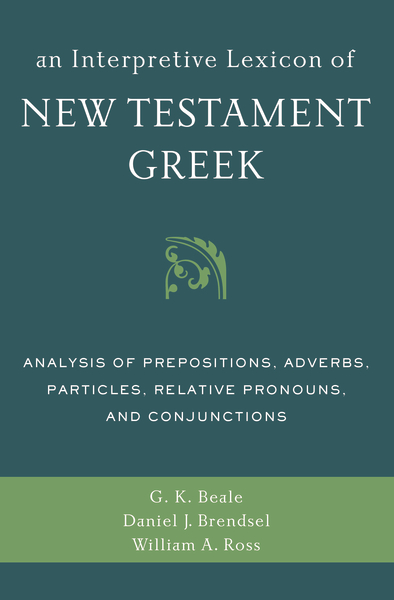Your Guide to Translating Clausal Relationships in the New Testament — An Excerpt from "Interpretive Lexicon of New Testament Greek"
Sometimes a resource comes along you didn't even know you needed until it does.
That seems to be the case with the new An Interpretive Lexicon Of New Testament Greek. This handy guide analyzes prepositions, adverbs, particles, relative pronouns, and conjunctions to help you intuit relationships between clauses and sentences and aid your exegetical process.
In the excerpt below, authors Gregory K. Beale, Daniel Joseph Brendsel, William A. Ross describe this exegetical handbook in this way:
"The [Interpretive Lexicon of New Testament Greek] examines and categorizes such key words found in the Greek New Testament that indicate relationships between clauses and that are therefore integral to conveying and supporting a main idea (or main ideas) in communication."
Read their excerpt to not only better understand the relationships between clauses and sentences, but how this guide will benefit your translation of meaningful communication from New Testament Greek.
Meaningful extended communication is built on relationships (often logical) between the statements or propositions we make. When someone says, “Since it is cold outside, therefore I am going inside,” the first proposition (“it is cold outside”) bears a certain logical relationship to the second proposition (“I am going inside”). In this instance we are helped in discerning the logical relationship by the key linking words “since” and “therefore.” In other cases, the relationship between distinct propositions is not signaled by a linking word or other verbal sign. But the relationship still plausibly exists. So, for example, one might say, “It is cold outside; I’m going inside,” and we may safely infer the same logical relationship as in our initial example, even though the words “since” and “therefore” are not present.
In communication we are always implicitly assuming or intuiting these relationships between clauses and sentences, whether we are aware of it or not. Everyday communication is thus built on meaningful relationships between the statements we make. Likewise, the New Testament’s communication entails meaningful and logical relationships between statements or propositions. These relationships are especially apparent in genres using more explicit logical arguments — in particular, in the New Testament epistles. They are a little more difficult, though not altogether impossible, to discern in, for example, poetic literature and narratives.
Attempting to discern logical relationships between propositions (which some refer to as “discourse analysis”) is a way of (1) making explicit what we might otherwise assume, in order (2) to test whether our assumptions are correct or incorrect or in need of refinements, with the result that (3) our understanding of a text is strengthened as we trace out an author’s flow of thought in support of a main point.
With this in mind, this Interpretive Lexicon of New Testament Greek is intended as an aid for discerning logical relationships between propositions in order to enhance exegesis. The specific help that this Lexicon provides is a taxonomy of functions performed by key Greek connecting words, particles, and other markers. In the example sentences given in the first paragraph above, the key words “since” and “therefore” helped to signal a certain kind of relationship (in the example, a logical relationship) between two clauses. Similarly in the Greek New Testament, words such as ἐπεί and οὖν signal certain meaningful relationships between clauses.
In short, this Lexicon examines and categorizes such key words found in the Greek New Testament that indicate relationships between clauses and that are therefore integral to conveying and supporting a main idea (or main ideas) in communication. These words include prepositions, conjunctions, adverbs, particles, and relative pronouns, among others, as our title suggests. Note that while great effort has been made toward thoroughness in this Lexicon, we have not exhaustively treated all New Testament Greek prepositions, adverbs, particles, and the like. Rather, we have focused on the most common words, or words that are otherwise significant for discerning logical relationships between clauses.
For each Greek word considered, the various relationships between propositions that the word may represent or indicate are listed and various English renderings are suggested for translation. A very cursory explanation of analyzing logical relationships (i.e., a kind of discourse analysis) and the methodology used to label and categorize the use of Greek words is given below. (5-7)
 An Interpretive Lexicon Of New Testament Greek
An Interpretive Lexicon Of New Testament Greek
By Gregory K. Beale, Daniel Joseph Brendsel, and William A. Ross
Buy it Today:
Amazon
Barnes & Noble
ChristianBook.com
Buy Direct from Zondervan
Thank you!
Sign up complete.

